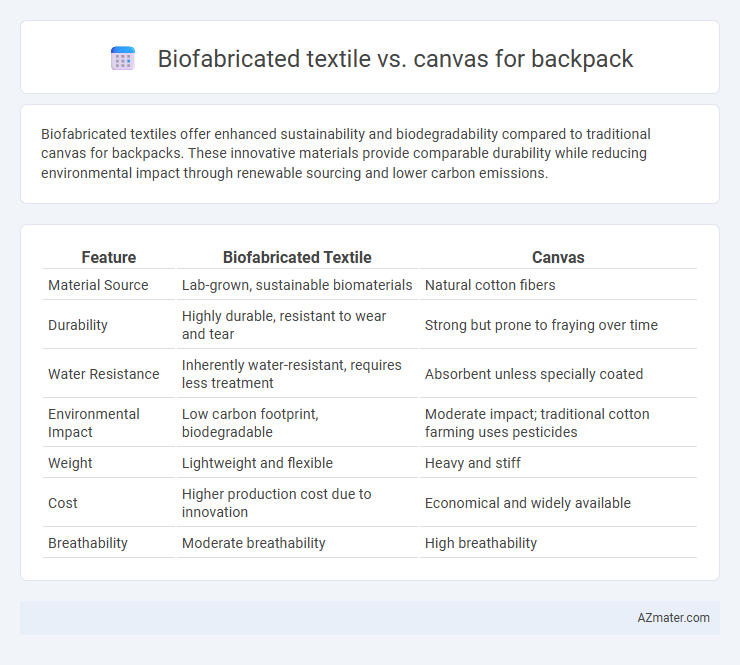Biofabricated textiles offer enhanced sustainability and biodegradability compared to traditional canvas for backpacks. These innovative materials provide comparable durability while reducing environmental impact through renewable sourcing and lower carbon emissions.
Table of Comparison
| Feature | Biofabricated Textile | Canvas |
|---|---|---|
| Material Source | Lab-grown, sustainable biomaterials | Natural cotton fibers |
| Durability | Highly durable, resistant to wear and tear | Strong but prone to fraying over time |
| Water Resistance | Inherently water-resistant, requires less treatment | Absorbent unless specially coated |
| Environmental Impact | Low carbon footprint, biodegradable | Moderate impact; traditional cotton farming uses pesticides |
| Weight | Lightweight and flexible | Heavy and stiff |
| Cost | Higher production cost due to innovation | Economical and widely available |
| Breathability | Moderate breathability | High breathability |
Introduction: The Evolution of Backpack Materials
Biofabricated textiles represent a revolutionary shift in backpack materials, offering sustainable alternatives to traditional canvas fabrics known for their durability and classic texture. Advances in biotechnology enable the production of biofabricated textiles from renewable resources, reducing environmental impact while maintaining or enhancing strength and water resistance. As consumers demand eco-friendly options, biofabricated textiles are increasingly favored for lightweight, breathable, and biodegradable backpacks, marking a significant evolution from conventional canvas.
What is Biofabricated Textile?
Biofabricated textiles are innovative materials produced through biological processes involving microorganisms, cells, or enzymes to create sustainable and eco-friendly fabrics. Unlike traditional canvas made from cotton or synthetic fibers, biofabricated textiles reduce environmental impact by minimizing water usage, chemical treatments, and carbon emissions. These materials offer durability and flexibility, making them an emerging alternative for backpack manufacturing with enhanced biodegradability and reduced ecological footprint.
Traditional Canvas: Composition and History
Traditional canvas is a durable, heavy-duty fabric typically composed of cotton or linen fibers woven in a plain weave, renowned for its strength and longevity in applications like backpacks. Originating in ancient times, canvas has been used for sails, tents, and bags, with its rugged texture and breathability making it a reliable choice for outdoor gear. Unlike biofabricated textiles, canvas is a natural material that offers proven resilience and classic aesthetics but lacks the sustainability benefits of innovative bioengineered fabrics.
Sustainability: Biofabricated Textile vs Canvas
Biofabricated textiles drastically reduce environmental impact by utilizing lab-grown materials that eliminate the need for water-intensive crops and chemical treatments commonly required in traditional canvas production. Unlike canvas, often sourced from cotton or hemp involving significant land use and pesticide application, biofabricated textiles offer a renewable, biodegradable alternative with a smaller carbon footprint. This innovation supports sustainable backpack manufacturing with enhanced durability and lower ecological costs compared to conventional natural fibers.
Durability and Performance Comparison
Biofabricated textiles offer superior durability and enhanced resistance to wear, moisture, and UV exposure compared to traditional canvas, making them ideal for long-lasting backpacks. Their engineered fiber structure provides lightweight strength and improved flexibility, ensuring better performance under dynamic stress and heavy loads. Canvas, while strong and breathable, tends to absorb water and degrade faster over time, reducing its longevity and overall reliability in harsh outdoor conditions.
Weight and Comfort in Backpack Design
Biofabricated textiles offer significant advantages over traditional canvas in backpack design, primarily due to their lightweight composition, which reduces overall carry weight and enhances user comfort during prolonged wear. These innovative materials exhibit superior flexibility and breathability compared to the heavier, more rigid canvas, resulting in improved ergonomic support and reduced strain on the shoulders and back. Advances in biofabrication technology also enable customization of fiber density and texture, optimizing comfort without sacrificing durability.
Water Resistance and Weather Protection
Biofabricated textiles offer superior water resistance compared to traditional canvas, often incorporating advanced hydrophobic properties that prevent water absorption and maintain breathability. These innovative materials provide enhanced weather protection by resisting UV rays, mold, and mildew while remaining lightweight and flexible, making them ideal for outdoor backpacks. Canvas, although durable, tends to absorb water and can degrade faster under prolonged exposure to harsh weather conditions, requiring additional treatments for effective water resistance.
Cost Analysis: Production and Retail Perspective
Biofabricated textiles typically incur higher production costs due to advanced biotechnological processes and specialized raw materials, leading to a premium retail price compared to traditional canvas. Canvas benefits from established manufacturing infrastructure and abundant natural fibers like cotton, resulting in lower production expenses and competitive pricing. Despite higher upfront costs, biofabricated textiles offer potential long-term savings through sustainability incentives and reduced environmental impact, appealing to eco-conscious consumers willing to invest in innovative backpack materials.
Aesthetics and Design Flexibility
Biofabricated textiles offer superior design flexibility compared to traditional canvas, allowing intricate patterns and textures that enhance backpack aesthetics. These innovative materials can be engineered for unique color variations and finishes, providing a modern, sustainable appeal. Canvas, while durable and classic, often lacks the adaptability for avant-garde designs and customization found in biofabricated textiles.
Future Trends: The Shift Toward Biofabricated Materials
Biofabricated textiles are emerging as a sustainable alternative to traditional canvas for backpacks, leveraging lab-grown fibers that reduce environmental impact and resource consumption. Innovations in biofabrication enable custom properties such as enhanced durability, breathability, and water resistance, surpassing conventional canvas performance. Future trends indicate a widespread adoption of biofabricated materials in outdoor gear, driven by increasing consumer demand for eco-friendly, high-performance fabrics.

Infographic: Biofabricated textile vs Canvas for Backpack
 azmater.com
azmater.com